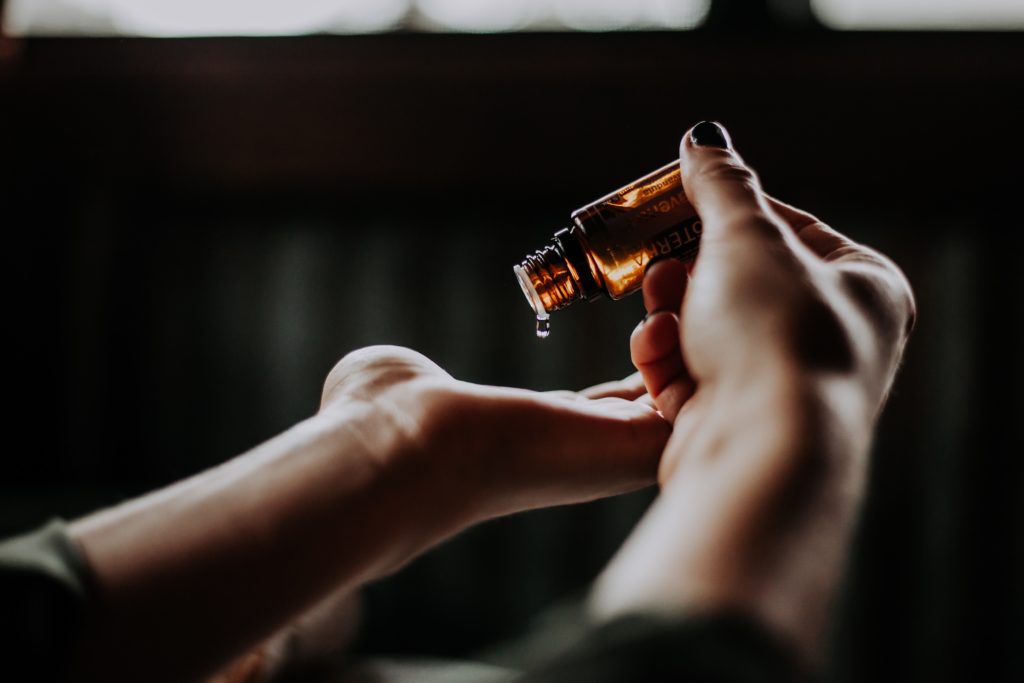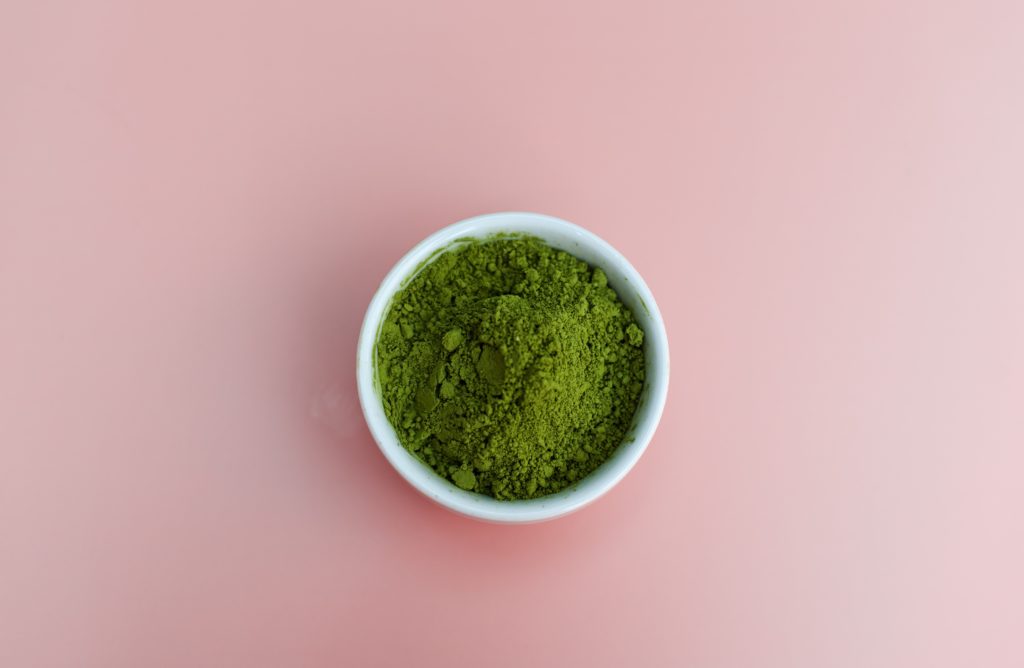Along with many other conditions, the prevalence of acne is on the rise, even for adult women. This increase in blemishes, inflammation, and other issues has led many to search for alternative solutions.
It’s no secret that the essential oils craze has been sweeping the nation for several years now, and skincare is no exception.
Proponents claim that you can use essential oils for acne, dry skin, and a bevy of other skincare needs. While I’ve said in the past that some natural oils are safe and gentle, not all of them are created equal.
What does the research say about essential oils for acne?
The Truth About Essential Oils & Breakouts
There are over 120 kinds of essential oils, and with their variety of uses and properties, understanding the truth about essential oils can feel overwhelming. 
Typically, frankincense, tea tree, and lavender oil are recommended for acne-prone skin, but do these really affect the frequency or severity of breakouts?
Acne breakouts are caused by bacterial growth within clogged pores on the skin when sebum is overproduced, typically by the Cutibacterium acnes (formally known as Propionibacterium acnes) bacteria.
Some oils that people claim reduce or treat acne breakouts include:
- Oregano
- Bergamot
- Tea tree
- Lavender
- Clary sage
- Lemongrass
Of the above, oregano oil has been tested against C acnes bacteria successfully, but only in a lab and with animal subjects. It’s a complicated suggestion, though, as oregano oil can actually burn the skin if applied incorrectly.
I’ll discuss the research on tea tree oil below, but it’s the only one that boasts human-based evidence for clinical effectiveness in treating acne.
But what this question comes down to is the experience I’ve had with patients.
As a dermatologist, I tend to see patients where most of what they have tried, including essential oils, didn’t work. There are certainly many people with acne where the essential oils where helpful and they did not need the assistance of a dermatologist to help clear their skin. However, personally, I believe much more research and understanding is needed before this becomes a well-tested method of treatment.
That being said, let’s look at the science of essential (and carrier) oils for acne to find out what might be on the horizon.
Non-Comedogenic Oils
Comedogenic oils are ones that tend to cause blackheads by blocking or clogging pores in the skin. This can cause an excess of sebum, the oil that creates acne. So, what oils will treat acne, rather than cause acne breakouts?
Before applying, it’s important to note that all new oils should be tested on a patch of skin for a reaction before widespread use on your face. This is especially important for sensitive skin.
Also, purchasing organic oils from trustworthy sources can help you avoid harsh chemicals and additives. Due to their concentrated nature, essential oils for acne should be diluted with a carrier oil like grapeseed or jojoba oil.

One of my personal favorites as a standalone or carrier oil is rosehip oil, which has anti-inflammatory properties, can hydrate dry skin as well as providing anti-aging benefits, and can help diminish dark spots and provide spot treatment for blemishes like acne scars. The benefits of rosehip oil are plentiful when it comes to treating acne.
Jojoba oil is a great option due to its healing qualities and hypoallergenic nature. Another oil that can stand alone or carry essential oils is sweet almond oil for all skin types. This removes excess sebum, your body’s oil production which can harden, clog pores, and lead to acne. This leaves you with a sensitive skin remedy for less pimples.
Tea Tree Oil for Acne
Many people who recommend essential oils for acne tout the benefits of tea tree oil as one of the best essential oils for acne treatment. Claims about that its antibacterial properties make it an excellent acne-fighting agent. However, let’s look at where the science stands.
First of all, you’ll want to keep this potent product away from little ones. Accidental ingestion of 100% tea tree oil can send small children to the hospital for poisoning and can be toxic for pets, especially cats.
Beyond ingestion, topical application of tea tree essential oil may cause hormonal abnormalities and atypical breast growth in prepubescent boys. (The same goes for lavender essential oil). You might want to think twice before using it on early pimples in preteen boys.
One study suggests that tea tree oil is a reasonably effective treatment in mild to moderate acne vulgaris, “significantly” reducing the number of blemishes. However, no severe cases were included, and the sample size was relatively small, so more research is needed to substantiate this claim.
Another study found that tea tree oil produces similar results to benzoyl peroxide, a common over-the-counter or prescription acne treatment found in face wash, cleanser, or acne cream. The tea tree oil was believed to be effective due to its anti-inflammatory properties. This study found only one difference: the tea tree oil took longer to show treatment results.
As you can see, tea tree oil may be helpful in treating acne when used with a carrier oil, such as rosehip mentioned above. Nevertheless, more research is needed and it has not proved more helpful than other natural remedies.
Natural Acne Treatment
Here’s a natural acne treatment recipe you can whip up at home:
- 1 tablespoon of matcha green tea powder
- 3 drops of organic tea tree oil
- 2 tablespoons of rosehip oil
Combine ingredients in a bowl, apply to face in a thin layer, avoiding eyes and mouth area.

Why? The polyphenols it contains are antibacterial, antifungal, and antimicrobial. They also can reduce sebum secretion and total number of zits on the face.
We’ve already discussed the benefits of rosehip oil in dark spot treatment and reducing inflammation, and tea tree oil’s potential benefits in reducing acne. Together, this mask, applied weekly, may naturally benefit your acne-fighting regimen.
For more of my natural DIY face masks, check out this article.
Don’t Use Coconut Oil for Acne

No, it’s not an essential oil, but the title says it all: using coconut oil for acne may simply feed the problem. Yes, its antimicrobial properties make it seem like a good fit as a facial carrier oil. However, unlike the oils listed above, coconut oil can be comedogenic, which means that it will aid in clogging pores.
Try one of my other favorite carrier oils, like rosehip, jojoba, sweet almond, or another from my list. Many of these carrier oils have beneficial properties of their own for treating acne.
Essential Oil Precautions
Here’s what you need to know about essential oils for acne (or even used for other purposes).
Before applying these to your face, there are some cautionary details you’ll want to know. Firstly, many essential oils are poisonous if used incorrectly. Be careful about ingesting or applying anything you haven’t researched thoroughly.
Specifically, cinnamon, clary sage, peppermint, and rosemary essential oil preferably should not be used on children.. Though essential oils are considered natural, this doesn’t automatically make them safe.
However, there is some data that supports using these oils in certain cases. For example, lavender oil, if inhaled while sleeping, improves sleep quality. Better sleep may balance hormones and reduce hormonal skin issues. In another study, it was found that both peppermint oil and eucalyptus oil could reduce some effects of headaches.
Using oregano essential oil for acne might sound like a good idea, but oregano can burn the skin unless paired with a good carrier oil. If you choose to use oregano, stick to only 1-2 drops of oil to 2 tablespoons of the carrier oil.
It’s important to note that most studies on the topic state that more research is needed in order to scientifically prove claims about essential oils. If all this information is causing more stress, feel free to diffuse some lavender oil for aromatherapy, which has been shown (in a small study) to provide a relaxing effect.
In Summary
- While the essential oils craze has many popular and practical uses, there is not yet a compelling body of evidence concerning essential oils for acne.
- Non-comedogenic oils like rosehip, jojoba, or sweet almond can be excellent carrier or standalone oils for treating various skin conditions.
- Tea tree essential oil has slight but promising research when used topically for acne, but only after puberty. There is very little evidence that other essential oils for acne are effective.
- Coconut oil should not be used on its own or as a carrier oil for acne treatment, as it can contribute to clogging pores, thus aggravating acne.
- Many types of essential oils are unsafe around children or have been linked to poisoning cases when ingested. It’s important to know the correct uses, as well as the side effects, of essential oils before using them.
Sources
- Albuquerque, R. G. R., Rocha, M. A. D., Bagatin, E., Tufik, S., & Andersen, M. L. (2014). Could adult female acne be associated with modern life?. Archives of dermatological research, 306(8), 683-688. Abstract: https://www.ncbi.nlm.nih.gov/pubmed/24952024
- Taleb, M., Abdeltawab, N., Shamma, R., Abdelgayed, S., Mohamed, S., Farag, M., & Ramadan, M. (2018). Origanum vulgare L. Essential Oil as a Potential Anti-Acne Topical Nanoemulsion—In Vitro and In Vivo Study. Molecules, 23(9), 2164. Full text: https://www.ncbi.nlm.nih.gov/pmc/articles/PMC6225355/
- Lin, T. K., Zhong, L., & Santiago, J. L. (2018). Anti-inflammatory and skin barrier repair effects of topical application of some plant oils. International journal of molecular sciences, 19(1), 70. Full text: https://www.ncbi.nlm.nih.gov/pmc/articles/PMC5796020/
- Phetcharat, L., Wongsuphasawat, K., & Winther, K. (2015). The effectiveness of a standardized rose hip powder, containing seeds and shells of Rosa canina, on cell longevity, skin wrinkles, moisture, and elasticity. Clinical interventions in aging, 10, 1849. Full text: https://www.ncbi.nlm.nih.gov/pmc/articles/PMC4655903/
- Valerón-Almazán, P., Gómez-Duaso, A. J., Santana-Molina, N., García-Bello, M. A., & Carretero, G. (2015). Evolution of Post-Surgical Scars Treated with Pure Rosehip Seed Oil. Journal of Cosmetics, Dermatological Sciences and Applications, 5(02), 161. Full text: https://pdfs.semanticscholar.org/8438/184f12f65fd18dbb32d24644413707078657.pdf
- Ranzato, E., Martinotti, S., & Burlando, B. (2011). Wound healing properties of jojoba liquid wax: an in vitro study. Journal of ethnopharmacology, 134(2), 443-449. https://www.ncbi.nlm.nih.gov/pubmed/21211559
- Jacobs, M. R., & Hornfeldt, C. S. (1994). Melaleuca oil poisoning. Journal of Toxicology: Clinical Toxicology, 32(4), 461-464. Abstract: https://www.ncbi.nlm.nih.gov/pubmed/8057407
- Henley, D. V., Lipson, N., Korach, K. S., & Bloch, C. A. (2007). Prepubertal gynecomastia linked to lavender and tea tree oils. New England Journal of Medicine, 356(5), 479-485. Abstract: https://www.ncbi.nlm.nih.gov/pubmed/17267908
- Enshaieh, S., Jooya, A., Siadat, A. H., & Iraji, F. (2007). The efficacy of 5% topical tea tree oil gel in mild to moderate acne vulgaris: a randomized, double-blind placebo-controlled study. Indian Journal of Dermatology, Venereology, and Leprology, 73(1), 22. https://www.ncbi.nlm.nih.gov/pubmed/17314442
- Bassett, I. B., Barnetson, R. S. C., & Pannowitz, D. L. (1990). A comparative study of tea‐tree oil versus benzoylperoxide in the treatment of acne. Medical Journal of Australia, 153(8), 455-458. Abstract: https://www.ncbi.nlm.nih.gov/pubmed/2145499
- Saric, S., Notay, M., & Sivamani, R. (2017). Green tea and other tea polyphenols: Effects on sebum production and acne vulgaris. Antioxidants, 6(1), 2. Abstract: https://www.ncbi.nlm.nih.gov/pubmed/28036057
- Elsaie, M. L., Abdelhamid, M. F., Elsaaiee, L. T., & Emam, H. M. (2009). The efficacy of topical 2% green tea lotion in mild-to-moderate acne vulgaris. Journal of drugs in dermatology: JDD, 8(4), 358-364. Abstract: https://www.ncbi.nlm.nih.gov/pubmed/19363854
- Lillehei, A. S., & Halcon, L. L. (2014). A systematic review of the effect of inhaled essential oils on sleep. The Journal of Alternative and Complementary Medicine, 20(6), 441-451. Abstract: https://www.ncbi.nlm.nih.gov/pubmed/24720812
- Göbel, H., Schmidt, G., Dworschak, M., Stolze, H., & Heuss, D. (1995). Essential plant oils and headache mechanisms. Phytomedicine, 2(2), 93-102. Abstract: https://www.ncbi.nlm.nih.gov/pubmed/23196150
- Sayorwan, W., Siripornpanich, V., Piriyapunyaporn, T., Hongratanaworakit, T., Kotchabhakdi, N., & Ruangrungsi, N. (2012). The effects of lavender oil inhalation on emotional states, autonomic nervous system, and brain electrical activity. Abstract: https://www.ncbi.nlm.nih.gov/pubmed/22612017
